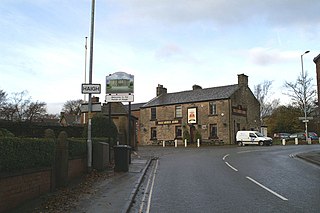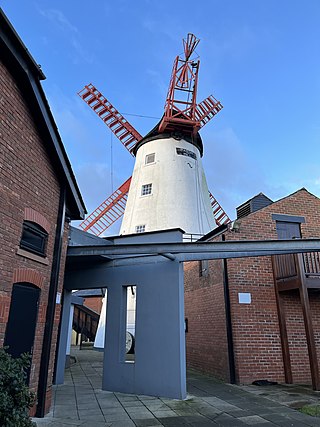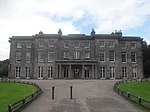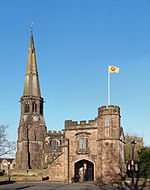
Haigh is a village and civil parish in the Metropolitan Borough of Wigan, Greater Manchester, England. Historically part of Lancashire, it is located next to the village of Aspull. The western boundary is the River Douglas, which separates the township from Wigan. To the north, a small brook running into the Douglas divides it from Blackrod. At the 2001 census it had a population of 594.

Helmshore Mills are two mills built on the River Ogden in Helmshore, Lancashire. Higher Mill was built in 1796 for William Turner, and Whitaker's Mill was built in the 1820s by the Turner family. In their early life they alternated between working wool and cotton. By 1920 they were working shoddy as condensor mule mills; and equipment has been preserved and is still used. The mills closed in 1967 and they were taken over by the Higher Mills Trust, whose trustees included historian and author Chris Aspin and politician Dr Rhodes Boyson, who maintained it as a museum. The mills are said to the most original and best-preserved examples of both cotton spinning and woollen fulling left in the country that are still operational.

Coppull Mill is a former cotton spinning mill in Coppull, Chorley, Lancashire. It was opened in 1906 by the Coppull Ring Spinning Co, followed by its sister mill, Mavis Mill in 1908. Together they employed 700 workers. The mill was taken over by the Lancashire Cotton Corporation in 1941 and passed to Courtaulds in 1964. The building is a Grade II listed building and is now used as an enterprise centre. This was a ring mill. It was driven by a 1600 hp triple-expansion four-cylinder engine by J & E Wood built in 1906. Its 26-foot (7.9 m) flywheel operated at 68 rpm and ran 36 ropes.

Haigh Hall is a historic country house in Haigh, Wigan, Greater Manchester, England. Built between 1827 and 1840 for James Lindsay, 7th Earl of Balcarres, it replaced an ancient manor house and was a Lindsay family home until 1947, when it was sold to Wigan Corporation. The hall is recorded in the National Heritage List for England as a designated Grade II* listed building and is owned by Wigan Council.

Ellenroad Mill was a cotton spinning mill in Newhey, a village in the Milnrow area of Rochdale, England. It was built as a mule spinning mill in 1890 by Stott and Sons and extended in 1899. It was destroyed by fire on 19 January 1916. When it was rebuilt, it was designed and equipped as a ring spinning mill.

Marsh Mill is an 18th-century tower windmill in Thornton, Lancashire, England. It was built in 1794 by Ralph Slater for local landowner Bold Hesketh. It functioned as a corn mill until the 1920s and has been fully restored. It is a good example of a complete English windmill and has been designated a Grade II* listed building.

Clarence Mill is a five-storey former cotton spinning mill in Bollington, Cheshire, in England. It was built between 1834 and 1877 for the Swindells family of Bollington. It was built alongside the Macclesfield Canal, which opened in 1831.
Barnfield Mills was a complex of cotton mills that operated in Tyldesley, Greater Manchester, England from the middle of the 19th century.

Swan Lane Mills is a former cotton mill complex in Bolton, Greater Manchester. All three mills are Grade II* listed buildings. The mills were designed by Stott and Sons of Oldham. When completed, the double mill was the largest spinning mill in the world. It was granted Grade II* listed status on 26 April 1974. Number 3 Mill was separately listed as Grade II* on the same day.

Victoria Mill is a Grade II* listed nineteenth century cotton spinning mill in Miles Platting, Manchester. It was a double mill designed by George Woodhouse completed in 1869.

Mather Lane Mills was a complex of cotton mills built by the Bridgewater Canal in Bedford, Leigh in Lancashire, England. The No 2 mill and its former warehouse are grade II listed buildings.

Joanne Marie Platt is a British former Labour and Co-operative politician who served as the Member of Parliament (MP) for Leigh from 2017 to 2019. She served on the opposition front bench as a Shadow Cabinet Office Minister from 2018 to 2019.
Worthington is a civil parish in the Metropolitan Borough of Wigan, Greater Manchester, England. It contains three listed buildings that are recorded in the National Heritage List for England. Of these, two are listed at Grade II*, the middle grade, and the other is at Grade II, the lowest grade. The parish is rural with no significant settlement, and the listed buildings are all houses.
Abram is a village in the Metropolitan Borough of Wigan, Greater Manchester, England. The village and the settlement of Platt Bridge contain two listed buildings that are recorded in the National Heritage List for England. Both the listed buildings are designated at Grade II, the lowest of the three grades, which is applied to "buildings of national importance and special interest". The listed buildings are a house and a farmhouse.
Aspull is a village in the Metropolitan Borough of Wigan, Greater Manchester, England. The village and the surrounding countryside contain 21 listed buildings that are recorded in the National Heritage List for England. Of these, one is listed at Grade II*, the middle of the three grades, and the others are at Grade II, the lowest grade.
Atherton is a town in the Metropolitan Borough of Wigan, Greater Manchester, England. The town and its suburbs of Howe Bridge and Hindsford contain 17 listed buildings that are recorded in the National Heritage List for England. Of these, four are listed at Grade II*, the middle of the three grades, and the others are at Grade II, the lowest grade.
Leigh is a town in the Metropolitan Borough of Wigan, Greater Manchester, England. The town, together with its suburbs of Bedford, Westleigh and Pennington, contains 33 listed buildings that are recorded in the National Heritage List for England. Of these, four are listed at Grade II*, the middle of the three grades, and the others are at Grade II, the lowest grade.
Wigan is a town in the Metropolitan Borough of Wigan, Greater Manchester, England. The town, together with the outlying townships of Pemberton, Scholes, Whelley, Worsley Mesnes, Winstanley, and Goose Green,, contains 286 listed buildings that are recorded in the National Heritage List for England. Of these, 31 are listed at Grade II*, the middle of the three grades, and the others are at Grade II, the lowest grade.

Hope Mill on Pollard Street, in the district of Ancoats, Manchester, England, is a cotton mill dating from 1824. A steam-driven mill, its engines were constructed by the Birmingham firm of Boulton and Watt. Derelict by the mid-20th century, the building was redeveloped in 2001 and now houses a range of creative industries, including the Hope Mill Theatre. Hope Mill is a Grade II* listed building.

















